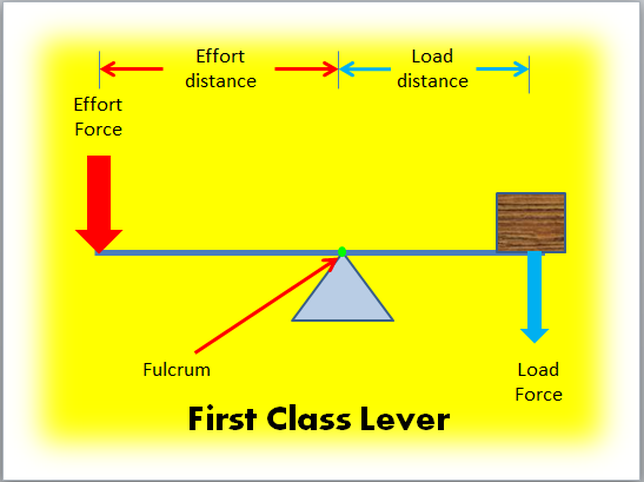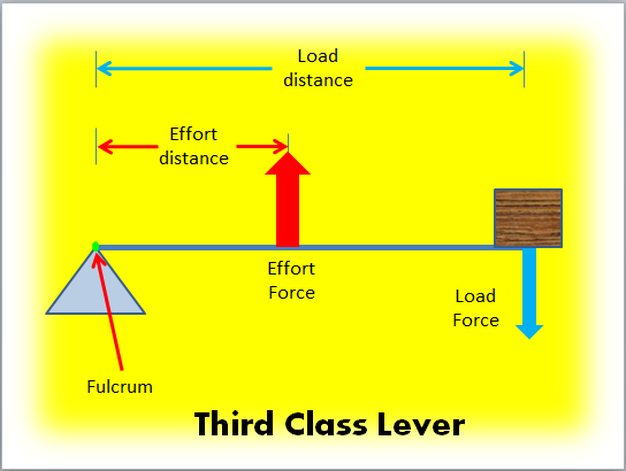6.3 - Levers
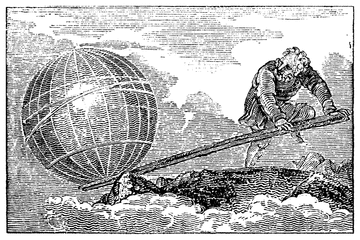
Levers come in three different classes. They are appropriately named first, second, and third class. Even though there are three classes, all levers have common traits.
Five basic parts:
- Fulcrum - the point around which the lever arm rotates.
- Load force - the weight of the "thing" that is meant to be moved.
- Load distance - the distance measured from the fulcrum to the load.
- Effort force - the force that is applied to the lever in order to move the load.
- Effort distance - the distance measured from the fulcrum to the effort force.
First Class Levers

The first class lever is probably the most common type of lever found. The most obvious example is the seesaw or the teeter-totter. With a first class lever the fulcrum is found between the two forces. It does not have to be exactly between them. To get a greater mechanical advantage, the fulcrum is normally placed closer to the load force.
Both the magnitude and the direction of the force are changed with a first class lever. If you push up, the load goes down. If you push down, the load goes up. By moving the fulcrum closer to the load force one decreases the effort force required. The smaller effort force has a greater distance to move to get the same amount of work done.
Both the magnitude and the direction of the force are changed with a first class lever. If you push up, the load goes down. If you push down, the load goes up. By moving the fulcrum closer to the load force one decreases the effort force required. The smaller effort force has a greater distance to move to get the same amount of work done.
Second Class Levers
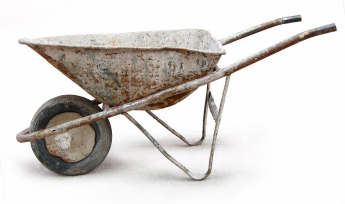
With a second class lever, the load force is found between the effort and the fulcrum. An example of a second class lever is the wheel barrow. Like the first class lever, the second class also has the fulcrum closer to the load force, so as to decrease the effort force required. Unlike the 1st class, the second does not change the direction of the force. Both the effort and the load go in the same direction.
Remember that the distances are measured from the fulcrum to the force. This means that the effort distance is the entire length of the lever. With the first class lever, the sum of the distances make up the length of the lever.
Remember that the distances are measured from the fulcrum to the force. This means that the effort distance is the entire length of the lever. With the first class lever, the sum of the distances make up the length of the lever.
Third Class Levers
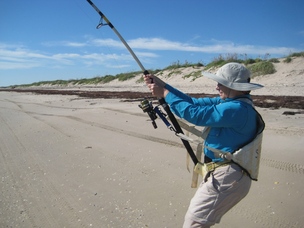
The third class lever must have the effort force between the fulcrum and the load force. This makes the third class lever very different than a first or a second. With the first and second class levers, the mechanical advantage is greater than one. The person using the lever is going a longer distance so as to use a smaller force. With the third class lever, the person applies a larger force so that she can go a shorter distance. The mechanical advantage is less than one!
An example of a third class lever would be a fishing rod. The end of the rod handle is the spot that doesn’t move, so that’s the fulcrum. She applies the effort force where her hands are. The load force is the weight of the fish at the end of the line. When casting, the angler moves her hands a small distance with a large force. This makes the end of the rod go a longer distance and it therefore is going a faster speed. The faster the rod is going, the further the bait goes on a cast.
Other examples of third class levers include most sporting equipment: baseball bats, hockey and lacrosse sticks, tennis rackets, and diving boards.
An example of a third class lever would be a fishing rod. The end of the rod handle is the spot that doesn’t move, so that’s the fulcrum. She applies the effort force where her hands are. The load force is the weight of the fish at the end of the line. When casting, the angler moves her hands a small distance with a large force. This makes the end of the rod go a longer distance and it therefore is going a faster speed. The faster the rod is going, the further the bait goes on a cast.
Other examples of third class levers include most sporting equipment: baseball bats, hockey and lacrosse sticks, tennis rackets, and diving boards.
6.3 Sample Problem 1 - First Class Levers
6.3 Sample Problem 2 - Second Class Levers
6.3 Sample Problem 3 - Third Class Levers
6.3 Review Questions
| 6.3_review_questions.pdf | |
| File Size: | 129 kb |
| File Type: | |
